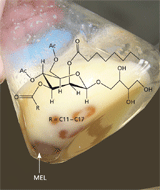Surfactants are an integral part of our daily lives with applications ranging from detergents and cleaning agents to additives in food production or even oil extraction. About 18 million tons of surfactants are produced annually, mostly by chemical means and based on crude oil. One quarter is now produced from the oils of renewable raw materials, usually coconut or palm kernel oil.
BioSurf - New production strategy for biosurfactants
Biosurfactants - surface-active substances from microorganisms

Microorganisms also produce surface-active substances called biosurfactants. Only a few of these biosurfactants are already produced industrially, as their manufacture is still comparatively cost-intensive. In the BioSurf project, Fraunhofer IGB is coordinating a consortium of seven partners, funded by the "ERA-NET Industrial Biotechnology" program, which is driving forward the development of new cost-effective processes for the microbial and enzymatic production of biosurfactants. This involves the development of new enzymes for the biotechnological synthesis of surfactants as well as the selection of microorganisms, in particular fungi of the genus Pseudozyma, and their optimization using molecular biological methods. The aim is to optimize the surfactant effect of the new biosurfactants and make their production more efficient.
Advantages of biosurfactants
In comparison to conventionally produced surfactants from petroleum raw materials, bio-surfactants are only slightly toxic, biocompatible and biodegradable with often better surfactant properties. They can also have a more complex structure and thus have a wider spectrum of activity. Many biosurfactants have an antimicrobial effect, which makes them interesting for the skin as components of cleansing products. Some biosurfactants are good foaming agents and bind dirt which is why they are used in shower gels, shampoos or hand dishwashing liquids. Bioactive effects on human cells also make biosurfactants interesting for the pharmaceutical sector.


Optimized fermentation for glycolipids
Within Fraunhofer IGB we focus in particular on the development of new fermentation processes for the production of mannosylerythritol lipids (MEL) and cellobioselipids (CL) from Pseudozyma species. In addition, we are investigating the structural optimization of glycolipids following fermentation, for example by means of enzymes. Important parameters for the fermentation process are optimized growth conditions and a high product formation rate. In addition, the desired product composition should be achieved with as few impurities and by-products as possible. Here we are trying to optimize the product spectrum of the microorganisms as well as the fermentation conditions, also by means of metabolic engineering. A further challenge is the economical processing of the substances from the fermentation broth. Many surfactants are also foaming agents, which can disrupt the fermentation process and must therefore be controlled.
Biosurfactant variants for application tests
The MEL and CL are formed in different variants depending on the micro-organism used. In order to be able to isolate as many of these variants as possible, 11 strains have so far been tested for their product spectrum. At present, we are producing sample substances of MEL and CL on a smaller scale for application tests within the consortium. Product concentrations of up to 100 g/L for MELs and 33 g/L for CL are achieved.
Enzymatic optimization and metabolic engineering
To generate further surfactant variants, a MEL mixture produced by P. aphidis was deacetylated with the aid of a lipase and the product thus obtained was tested for its surfactant effect. Various structural variants with modified surfactant properties were also produced from cellobioselipids. Genome-wide investigations of a particularly efficient MEL producer using parallel sequencing methods enabled us to identify the genes required for MEL biosynthesis. These now serve as a blueprint for the metabolic engineering of the strain with the aim of obtaining MEL variants with tailor-made properties.
Future work will focus on the scale-up of fermentation processes down to the cubic metre scale and the corresponding processing methods.
Literature
Günther, M.; Zibek, S. ; Hirth, T. ; Rupp, S. (2010) Synthese und Optimierung von Cellobioselipiden und Mannosylerythritollipiden. Chem. Ing. Tech. 82: 1215-1221
Project information
Project duration
2011 – 2014
Project partners
- Karlsruhe Institute of Technology KIT, Karlsruhe
- c-LEcta GmbH, Leipzig
- Flemish Institute for Technological Research, Mol, Belgium
- Tormans Engineering Noord BVBA, Geel, Belgium
- Ecover Belgium NV, Malle, Belgium
- LISBP, Toulouse, France
 Fraunhofer Institute for Interfacial Engineering and Biotechnology IGB
Fraunhofer Institute for Interfacial Engineering and Biotechnology IGB